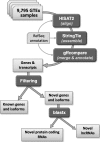CHESS: a new human gene catalog curated from thousands of large-scale RNA sequencing experiments reveals extensive transcriptional noise
- PMID: 30486838
- PMCID: PMC6260756
- DOI: 10.1186/s13059-018-1590-2
CHESS: a new human gene catalog curated from thousands of large-scale RNA sequencing experiments reveals extensive transcriptional noise
Abstract
We assembled the sequences from deep RNA sequencing experiments by the Genotype-Tissue Expression (GTEx) project, to create a new catalog of human genes and transcripts, called CHESS. The new database contains 42,611 genes, of which 20,352 are potentially protein-coding and 22,259 are noncoding, and a total of 323,258 transcripts. These include 224 novel protein-coding genes and 116,156 novel transcripts. We detected over 30 million additional transcripts at more than 650,000 genomic loci, nearly all of which are likely nonfunctional, revealing a heretofore unappreciated amount of transcriptional noise in human cells. The CHESS database is available at http://ccb.jhu.edu/chess .
Keywords: GTEx; Human gene count; RNA sequencing; Transcriptome; Transcriptome assembly.
Conflict of interest statement
Ethics approval and consent to participate
Not applicable.
Consent for publication
Not applicable.
Competing interests
The authors declare that they have no competing interests.
Publisher’s Note
Springer Nature remains neutral with regard to jurisdictional claims in published maps and institutional affiliations.
Figures





Comment in
-
We simply cannot go on being so vague about 'function'.Genome Biol. 2018 Dec 18;19(1):223. doi: 10.1186/s13059-018-1600-4. Genome Biol. 2018. PMID: 30563541 Free PMC article.
References
-
- Liang F, Holt I, Pertea G, Karamycheva S, Salzberg SL, Quackenbush J. Correction: gene index analysis of the human genome estimates approximately 120,000 genes. Nat Genet. 2000;26:501. - PubMed
Publication types
MeSH terms
Grants and funding
LinkOut - more resources
Full Text Sources
Other Literature Sources

